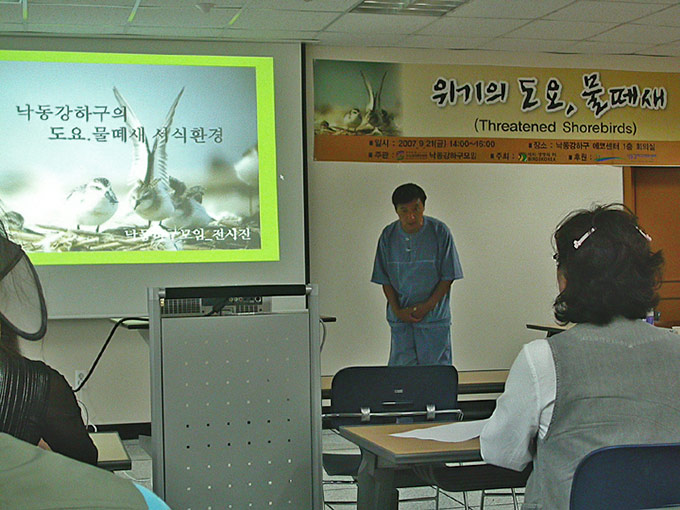Following the successful symposium celebrating "The Great Migration of Shorebirds" held at Mokpo Natural History Museum on September 14th (with an exhibition of images and shorebird information by BirdDB and Birds Korea remaining open until October 16th), Birds Korea this time partnered up with the local Nakdong Estuary Conservation Group (Nakdong Hagu Moum) in Busan on September 21st, to hold a seminar on "Threatened Shorebirds of the Flyway". Although intended as a very small-scale discussion, over 30 persons and even a TV crew from KNN attended the seminar, which was generously hosted by the Nakdong Estuary Eco-Centre. Presentations relating to shorebird and tidal-flat conservation were given by Mr. Jeon Shi-Jin (Director of the Nakdong Estuary Conservation Group – a specialist organization within Busan KFEM), Ms. Park Meena (the National Coordinator of Birds Korea), Mr. Jan van de Kam (professional wildlife photographer and Birds Korea international member, responsible for the astonishing images in "Shorebirds: An Illustrated behavioural ecology" and other publications), Mr. Mo In-Ho (an excellent local bird photographer and videographer and member of the Nakdong Estuary Conservation Group), and Mr. Ju Yong-Ki, Birds Korea’s Formal Advisor on Saemangeum and the Geum Estuary.

Photo © Birds Korea.
One common theme throughout the presentations was the continuing threat to the Nakdong Estuary and to Korean inter-tidal wetlands in general, especially through reclamation and degradation; another theme was the remarkable decline of one of Asia’s most charismatic bird species – the Spoon-billed Sandpiper. As recently as mid-September 1970, "several hundred" Spoon-billed Sandpiper were recorded on the mud-flats of the Nakdong Estuary by Professor Won Pyong-Oh, the father of South Korean ornithology. Since the late 1990s, by contrast, only three to eight "spoonies" have been recorded in the estuary annually, almost all juveniles in September. This steep decline at the Nakdong was likely caused by the barraging of the estuary in the late 1980s, as well as by a series of subsequent reclamations that have greatly increased disturbance and caused the loss of significant areas of tidal-flat. In turn, this loss of optimal habitat at the Nakdong Estuary for several hundred staging Spoon-billed Sandpiper has no doubt contributed greatly to the decline of the species overall – a decline further exacerbated by the ongoing Saemangeum reclamation. From a historic population of perhaps 60,000, the Spoon-billed Sandpiper’s global population has been estimated this year as possibly down to only 100 or so breeding pairs…
Through the coming months, Birds Korea will continue to do all we can with other conservation organizations to raise awareness of and win protection for Korea’s most threatened shorebird species – most especially the Spoon-billed Sandpiper, Nordmann’s Greenshank and Eastern Oystercatcher. Please join us!



